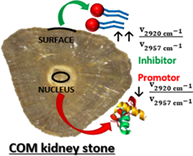Calcium oxalate kidney stones, where is the organic matter?: A synchrotron based infrared microspectroscopy study
Funding information: ALBA Synchrotron, Grant/Award Numbers: 2016021675, 2016021706; Ministerio de Economía y Competitividad, Grant/Award Number: CMT 2015-65414-C2-1-R; SOLEIL Synchrotron, Grant/Award Numbers: 20150877, 20151226; Universitat Autònoma de Barcelona, Grant/Award Number: PIF-2016
Abstract
Kidney stones are collections of microcrystals formed inside the kidneys, which affect 6% to 12% of the population worldwide, with an increasing recurrence (50%-72%) after the first episode. The most abundant type is calcium oxalate (66%), described as monohydrated (COM) and dihydrated (COD). An issue in their chemistry is the transformation process of the metastable specie (COD) into the stable one, which is chemically, and in appearance, monohydrated. Since the origin of these species is different, it is important to differentiate between the transformation stage (and what stabilize COD) to understand the physiopathology and prevent the patients' recurrence. This work focuses on the organic matter distribution along these nephroliths by synchrotron radiation-based infrared microspectroscopy. Differences in the asymmetric stretching of the aliphatic hydrocarbons suggest that lipids may participate in the stabilization of COD and as inhibitors of COM formation/development; however, the presence of proteins in the nucleus could indicate a promoting role.
CONFLICT OF INTEREST
The authors declare no potential conflict of interest.
Open Research
DATA AVAILABILITY STATEMENT
The data that support the findings of this study are available from the corresponding author upon reasonable request.




